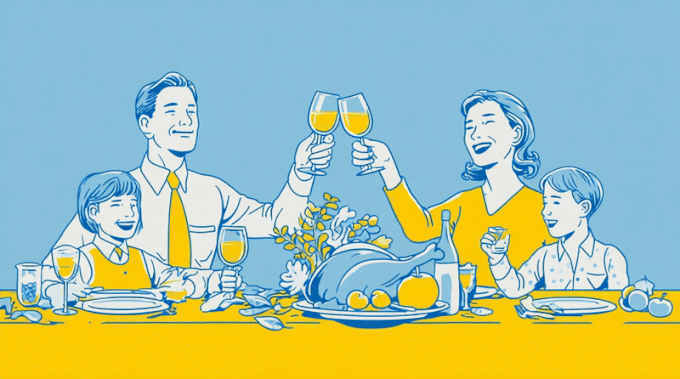Summary: A family group chat about Thanksgiving dinner reflects centuries of extraordinary advancement. The same journey that once separated families by months can now be made in hours. A meal that was once a rare luxury has become highly affordable. From instant communication to abundant food, everyday conveniences serve as a reminder that human ingenuity has transformed hardship into prosperity.
Two weeks before Thanksgiving, my sister sent a link to our family group chat. It wasn’t an RSVP form; it was closer to an online wedding gift registry. All the Thanksgiving classic foodstuffs were on the list—turkey, honey baked ham, mashed potatoes, gravy, stuffing, cranberry sauce, candied yams, green bean casserole, pumpkin pie, and more—each with a sign-up slot to commit to bringing the goods. This brief interaction represented numerous aspects of human progress, and I paused to take it in with awe and gratitude.
For one, I live in Boston, not far from where the original Thanksgiving Pilgrims settled in Plymouth, while my family lives in Los Angeles. The distance between us is almost identical to the distance between Britain and the New World, roughly 3,000 miles across land instead of ocean. Yet, the majority of Pilgrims never returned home and never even had the opportunity to stay in contact with the world they left behind. A letter across the Atlantic would cost days’ worth of wages and take months to arrive, if it found safe passage at all.
By the time the first Americans began settling in California in the 1840s, locomotives and the telegraph had been invented, but no transcontinental systems had yet been established. Most westward settlers knew they were signing up for a one-way journey taking many months, with high rates of death and disease. If they could maintain any contact with family on the other side of the continent, messages would take weeks via stagecoach. Even the extraordinarily speedy and expensive Pony Express system—with riders galloping nonstop at full speed, exchanging horses every 10-15 miles, and exchanging riders once or twice a day—still took 10 days to deliver messages across the country.
By the time the first transcontinental telegraph line was established in 1861, messages took minutes rather than weeks but were extraordinarily expensive—nearly a day’s average wage per word. Messages had to be brief and were largely reserved for the government, the military, and the ultra-wealthy. However, a decade later, the first transcontinental railroad was established, which, with the adoption of standardized domestic postage, meant most Americans could afford to send letters across the country and have them arrive within a week. Travel between Los Angeles and Boston became possible but still took weeks and cost several weeks’ worth of average wages.
Innovation accelerated even more rapidly during the 20th century with the invention and commercialization of telephones and air travel. By 1950, the luxuries of traveling between coasts in six hours and communicating across coasts in real time became possible. But these new services were still extraordinarily expensive. Transcontinental flights, both then and now, cost around $300; however, adjusted for inflation, a $300 flight in 1950 corresponds to well over $3,000 in today’s dollars. Likewise, while modern phone plans offer unlimited texts and calls for the equivalent of a few hours of the average minimum wage per month, transcontinental phone calls in the 1950s cost over $2.00 per minute, or over $27 per minute in today’s dollars. Only in the last 30 years, thanks to the economic engine of progress, did it become affordable for the average American to call long-distance for hours.
The technologies enabling long-distance communication and travel have improved immeasurably from the time of the Pilgrims. That alone is reason enough to be thankful. But besides the amazing pocket-sized supercomputers and the satellite infrastructure that made my family’s group message possible, our exchange hinted at another amazing development that people often take for granted: food abundance.
My father grew up in a small Palestinian village in northern Israel, where most people were farmers. He was one of nine siblings and told stories of how chickens were slaughtered only on special occasions—red meat even rarer. A single bird was shared among a dozen people. “You were lucky if you got a drumstick,” my father said. Everything from feeding to slaughtering and plucking was done by hand. And without refrigeration, the meal had to be eaten at once.
By contrast, in the United States today, food is so cheap and plentiful that several relatives can volunteer to bring a whole turkey. At my local supermarket, frozen birds were recently on sale for $0.47 per pound. A 15-pound turkey, enough to feed a family, costs less than an hour’s minimum wage.
I am grateful for the world of superabundance, which has improved our lives and Thanksgiving holidays beyond what our ancestors could have dreamed. The fact that these interactions are commonplace enough to be taken for granted—communicating in real time across vast distances, flying across the country or around the world in hours, earning enough calories with a day’s wages to feed a family for a week—make our story of progress all the better.
This Thanksgiving, take a moment to consider how life has improved since the time of the Pilgrims. The food on your plate, the technology in your pocket, and the family who traveled long distances to be at the table were all made possible thanks to generations of compounding progress.





